Top 15 Best Chess Books for Advanced Players
15 best chess books for advanced players rated above 1800+, ideal for deepening understanding, enhancing calculation, and mastering complex positions.
- Focus on solving positions deeply, not just passively reading.
- Use a physical board or visualization to test your blind calculation.
- Try analyzing your own games with these books as reference.
Selection Criteria for the Top 15 Chess Books for Advanced Players Choosing the best chess books for advanced players requires a careful balance of depth, practicality, and long-term learning value. The following criteria were used to curate this list of top-tier chess literature for players rated above 1800 Elo:
_______________________________________________________________________________
1. 
Each title delivers sophisticated concepts in calculation, strategy, endgames, and positional play. They’re crafted for readers who already understand core chess principles and are seeking high-level improvement.
________________________________________________________________________________
2. 
All selected books are authored by world-class grandmasters, elite coaches, or renowned chess thinkers.
____________________________________________________________________________________
3. 
We prioritized books that help readers win real games. Whether it’s improving decision-making under time pressure or refining positional judgment, each book is geared toward practical mastery over academic knowledge.
________________________________________________________________________________
4. 
To develop a well-rounded player, the list spans all key areas of advanced chess:
- Tactical calculation and visualization
- Strategic planning and positional understanding
- Dynamic attacking play
- Endgame technique
- Middlegame master
5. 
Advanced players learn best through problem-solving. Books with structured exercises, annotated examples, and training tasks were prioritized to promote active learning and mental engagement.
________________________________________________________________________________
6. 
Great chess books aren’t read once—they’re studied, revisited, and reabsorbed. Each entry on the list offers long-term value, remaining useful as players progress from 2000 to 2200+ and even beyond.
________________________________________________________________________________
Whether you’re chasing your next norm or refining your over-the-board instincts, these books are curated to serve as your personal grandmaster trainers in print.
1. The Complete Manual of Positional Chess by Konstantin Sakaev & Konstantin Landa
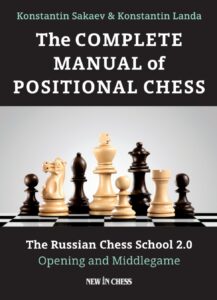
The Complete Manual of Positional Chess is a two-volume instructional guide aimed at ambitious club and tournament players looking to sharpen their positional understanding.
Authored by Grandmasters Konstantin Sakaev and the late Konstantin Landa, the book presents a systematic approach to positional play, covering themes like weak squares, pawn structures, maneuvering, open files, and much more.
Each topic is introduced clearly, illustrated with deeply annotated examples, followed by carefully chosen exercises.
Key concepts such as:
- Central control and tension
- Pawn breaks and space advantage
- Good vs. bad bishops
- Outposts and domination
Blockades and prophylaxis are presented with real-game examples, primarily from elite-level play.
Systematic and comprehensive
Challenging enough for serious tournament players
Excellent mix of explanation and exercises
Clear instructional language
If you’re want to level up your positional play in a structured, classroom-like manner, this book is gold.
A master-level training manual that delivers serious results for those willing to put in the work.
2. Secrets of Modern Chess Strategy by John Watson
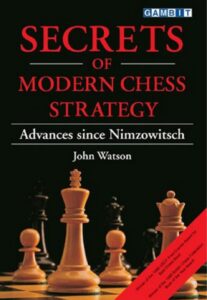
Secrets of Modern Chess Strategy: Advances since Nimzowitsch is John Watson’s bold and illuminating examination of how positional play has evolved in the modern era.This book offers a conceptual leap that reshapes your understanding of chess fundamentals in the 21st century.
Key themes include:
- Flexibility vs. rigidity in modern planning
- The evolution of piece activity
- Breaking traditional rules (e.g., doubled pawns, isolated pawns)
- Dynamic imbalance and hypermodern ideas
- Modern exchange sacrifices and dynamic pawn play
Each chapter combines clear explanations with richly annotated examples from modern grandmaster games that support established principles.

- Expands your strategic mindset
- Challenges outdated thinking in a constructive way
- High-quality, thoughtful prose and instruction
- Great for coaches and advanced independent learners
An insightful and provocative classic that redefines what “positional play” means in the modern chess world.
Secrets of Modern Chess Strategy isn’t a shortcut to easy wins—but it elevates your thinking, opening your mind to a more nuanced, adaptive, and dynamic style of play.
3. Learn from the Legends by Mihail Marin

Learn from the Legends by GM Mihail Marin is a strategic masterpiece that blends instructive clarity with reverence for classical chess. Rather than simply reliving famous games, Marin extracts timeless positional lessons from some of the greatest chess champions in history—Steinitz, Capablanca, Petrosian, Karpov, and others—making it an ideal study for players looking to improve their positional intuition and strategic patience.
Each chapter is dedicated to a chess legend and a specific recurring strategic theme in their play.
Marin uses these masters’ games to teach core positional themes in a deeply understandable yet nuanced way, often connecting the play of past champions to modern examples.
Rather than focusing on trendy theory or forcing systems, Marin zooms in on ideas that transcend generations. These themes are as relevant today as they were 50 years ago.
Marin’s annotations are packed with verbal explanations. He emphasizes why over what—helping readers develop independent judgment.

- Brilliant strategic content through annotated classics
- Deep insight into how legends approached chess
- Builds long-term understanding, not quick tricks
- Great value for both self-study and coaching
It’s especially suited for players around 1800–2300 Elo who want to refine their style and broaden their chess culture.
A modern classic. Mihail Marin teaches more than moves—he teaches how great minds think. Whether you’re aiming to play like the legends or simply understand their enduring brilliance, this book is a gem.
4. Game Changer by Matthew Sadler & Natasha Regan
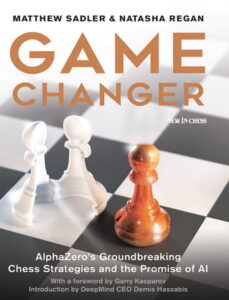
Game Changer isn’t just a book about a computer playing chess. It’s a deeply insightful and thought-provoking exploration of how AlphaZero, the self-learning AI created by DeepMind, is redefining strategic understanding at the highest level.
Written by GM Matthew Sadler and WIM Natasha Regan, this award-winning work blends detailed analysis, human insight, and cutting-edge AI chess games to create a bridge between machine genius and human learning.
The book presents dozens of AlphaZero’s spectacular games against Stockfish, annotated from both a human and machine perspective. But it’s far more than just games—it’s structured into strategic themes, including:
- The power of initiative and piece activity
- Long-term sacrifices and attacking potential
- King safety as a dynamic concept
- Central control and flexible pawn play
- Novel ideas in opposite-side castling and attack defense
The book shows AlphaZero playing with deep positional sacrifices, long-term initiative, and strategic risks that most humans wouldn’t consider. These games are filled with fresh ideas rarely seen in classical play.

- Bridges artificial intelligence and human chess thinking
- Filled with instructive, deeply annotated games
- Well-structured, with thematic organization and clarity
If you want to expand your strategic imagination, understand how AI sees the board, and gain inspiration from the future of chess, Game Changer delivers in every chapter.
5. Garry Kasparov – My Great Predecessors Series
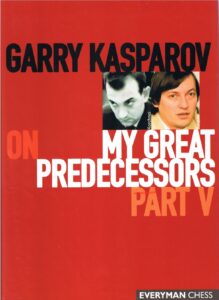
Garry Kasparov’s My Great Predecessors is a monumental five-volume series that chronicles the evolution of chess through the lives and games of the world champions who shaped the game. As one of the greatest players in history, Kasparov provides deep insights, combining historical narrative with sharp analytical commentary.
The series is structured as follows:
Volume I – Covers Steinitz, Lasker, Capablanca, and Alekhine
Volume II – Focuses on Euwe, Botvinnik, Smyslov, and Tal
Volume III – Examines Petrosian and Spassky
Volume IV – Dedicated to Fischer
Volume V – Discusses Karpov and Korchnoi (with additional coverage of other key players)
Kasparov not only analyzes the champions’ best games but also compares styles, evolution of ideas, and legacy, using his own understanding and modern engine insights.
Strengths of the Series
1. Historical Context & Biography
Kasparov doesn’t just analyze games—he brings the champions to life. Each volume provides rich biographical details, rivalries, and the political and cultural backdrop of their eras.
2. Deep Game Analysis
Kasparov’s annotations are both instructive and engaging. He explains key ideas, mistakes, and brilliancies with the precision of a top-tier grandmaster.
3. Critical Perspective
As a former world champion, Kasparov offers unique judgments on his predecessors’ strengths and weaknesses, sometimes challenging conventional wisdom.
4. Educational Value
The series is a goldmine for improving players. Studying these games helps develop strategic understanding, tactical awareness, and endgame technique.
My Great Predecessors is an essential chess library addition. Kasparov’s passion for the game shines through, making it both an educational resource and a captivating historical account. While not for absolute beginners, intermediate and advanced players will find immense value in these volumes.
My Great Predecessors isn’t a light read—but it’s a towering contribution to chess literature. Whether you’re an advanced player, a coach, or a fan of the game’s history, this series will sharpen your understanding and deepen your appreciation of the legends.
6. Grandmaster Preparation – Strategic Play by Jacob Aagaard

Jacob Aagaard’s Grandmaster Preparation – Strategic Play is part of his acclaimed Grandmaster Preparation series, designed to help serious players master advanced chess concepts.
Aagaard blends deep strategic understanding with practical decision-making, making this a standout work for ambitious players.
The book is divided into thematic sections, each building on the previous one, with exercises and annotated games.
Key Strengths
1. Deep yet Practical Strategic Lessons
Aagaard doesn’t just recite classic strategic rules—he explains how to think strategically. The book covers:
- Prophylaxis (preventing opponent’s plans)
- Weaknesses (how to exploit and create them)
- Piece Play (optimizing knights, bishops, and rooks)
- Transformation of Advantages (converting one type of advantage into another)
2. High-Quality Exercises
Each chapter includes well-selected puzzles reinforcing the concepts. Aagaard’s examples are deeply instructive.
3. Excellent Game Selection
The annotated games are carefully chosen to illustrate key ideas, featuring players like Karpov, Carlsen, and Capablanca, as well as Aagaard’s own games.
Grandmaster Preparation – Strategic Play is one of the best advanced strategy books available. Aagaard’s clear explanations, high-level exercises, and focus on practical decision-making make it a must-read for serious players.
7. From GM to Top Ten by Judit Polgar
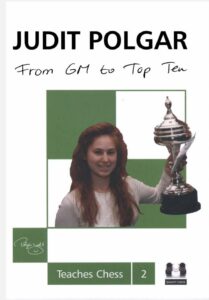
Judit Polgar’s From GM to Top Ten is the crowning volume of her acclaimed three-part autobiographical chess series, chronicling her phenomenal rise to the top echelons of world chess. This final installment captures her journey from a young Grandmaster into the elite circle of the world’s top ten players—an unprecedented achievement for a female player in a male-dominated sphere.
The book blends personal experiences, game analysis, and practical advice, making it both inspiring and instructive.
Polgar’s writing is as instructive as it is inspirational. The book is packed focusing on her most significant victories against world-class opponents such as Garry Kasparov, Vladimir Kramnik, Viswanathan Anand, and Veselin Topalov. What makes her annotations stand out is not just their technical precision but also the personal insights—her thoughts, preparation strategies, and emotional states during key moments. This narrative gives readers rare access to the mind of a world-class competitor.
Key Highlights
- Personal Journey & Mindset
- Polgar discusses her unique upbringing, trained under the “Polgar method” by her father, László Polgar.
- She emphasizes the importance of hard work, self-belief, and resilience in overcoming obstacles.
- Game Analysis & Improvement Tips
- The book includes annotated games from her career, showcasing her aggressive, tactical style.
- Polgar shares training routines and thought processes that helped her compete against the best.
- Breaking Barriers in Chess
As a woman who consistently defeated top male players, she offers insights into handling pressure and stereotypes.
Her victories over World Champions like Kasparov, Anand, and Karpet are analyzed in detail.
From GM to Top Ten is a must-read for serious chess players. Polgar’s combination of personal narrative and high-level chess content makes it both engaging and educational. Whether you’re looking for inspiration or practical improvement tips, this book delivers.
8. Soviet Middlegame Technique by Peter Romanovsky

Soviet Middlegame Technique by Peter Romanovsky is a classic chess book that delves into the strategic and tactical concepts that defined Soviet chess dominance.
Peter Romanovsky was not just a strong player—he was a teacher and thinker deeply invested in understanding the inner logic of chess. A two-time Soviet champion and a mentor too many rising stars of his era.
Romanovsky, a respected Soviet chess trainer, breaks down the middlegame into Key middlegame themes such as centralization, piece coordination, prophylaxis, and transformation of advantages. Illustrative examples from both classical and contemporary games.
- Pawn Structures – How pawn formations dictate piece play.
- Piece Coordination – Maximizing the efficiency of rooks, knights, and bishops.
- Attack and Defense – When to push for an attack and when to consolidate.
Its focus on planning, especially how to create and execute strategic ideas based on positional features.
In-depth explanations: Romanovsky’s commentary is rich with insight, especially helpful for club players looking to develop strategic understanding.
It’s particularly valuable for those who enjoy slower, positional struggles and want to refine their ability to formulate and execute middlegame plans.
Soviet Middlegame Technique is a must-read for serious chess players. While the notation and some analysis feel dated, the strategic lessons are timeless.
9. The Life and Games of Mikhail Tal by Mikhail Tal
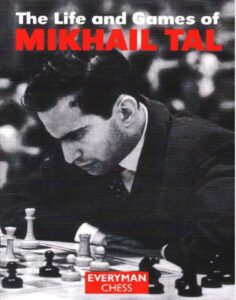
The Life and Games of Mikhail Tal. Written by the eighth World Chess Champion himself, this classic is more than just a collection of annotated games—it’s a vivid journey into the mind of one of the most imaginative and entertaining players the game has ever seen. It’s a celebration of creativity, courage, and the beauty of risk in chess.
Tal’s book is divided into two main sections:
Life – A candid account of his childhood, early chess career, battles with health issues, and the pressures of being World Champion.
A narrative style that reads like a memoir, rich with anecdotes and chess philosophy.
Deep yet accessible annotations: Perfect blend of explanation and excitement.
Many of Tal’s battles are masterpieces of attacking chess.
This book is also highly recommended for those seeking inspiration—not just technique.
✔ Entertaining & Engaging – Tal’s charisma shines through every page, making even non-chess sections a joy to read.
✔ Brilliant Annotations – He explains his sacrifices and attacks in a way that feels intuitive rather than overly technical.
✔ Historical Insight – The book provides a fascinating glimpse into Soviet chess culture and Tal’s rivalries with Botvinnik, Fischer, and others.
Attacking Players – Anyone who loves sacrifices, tactics, and bold play.
Chess History Fans – Those interested in the psychology of a genius and the golden era of Soviet chess.
Few chess books combine entertainment, instruction, and autobiography as masterfully as this one. Tal’s wit, creativity, and passion make this a must-read for every chess enthusiast.
10. Think Like a Grandmaster by Alexander Kotov
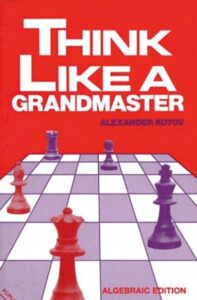
Think Like a Grandmaster is one of the most iconic chess books of the 20th century. Written by Soviet grandmaster Alexander Kotov, it aims to bridge the gap between club-level play and grandmaster-level thinking. Rather than focusing solely on tactics or strategy, Kotov dives into the mental process of calculating, choosing candidate moves, and evaluating positions under tournament conditions.
Kotov teaches you how to think. He famously introduces the concept of the “tree of analysis”, emphasizing how players must systematically explore and prune branches of possibilities to find the best continuation. His methods aim to make your thinking more structured, especially under time pressure.
Key Themes & Takeaways
The Tree of Analysis
Kotov introduces his famous “tree of variations” concept, explaining how strong players systematically analyze candidate moves.
A metaphor for disciplined, logical calculation—visualizing every move as a branch and analyzing each thoroughly.
Candidate Moves
One of the book’s most enduring lessons is the idea of listing candidate moves before calculating deeply.
Time Management & Blunders
Kotov discusses how poor time management leads to mistakes, advocating for efficient thinking habits.
Think Like a Grandmaster is a foundational classic that belongs on every serious chess player’s bookshelf. If you’re looking to transform your approach to calculation and positional thinking, Kotov’s insights are indispensable.
11. Together with Morozevich by Alexey Kuzmin

In Together with Morozevich, Alexey Kuzmin gives readers an intimate and analytical look into the mind of one of the most creative and enigmatic grandmasters of modern times—Alexander Morozevich. Known for his unorthodox openings and unpredictable play, Morozevich was a constant disruptor at the top level, and this book captures the essence of his style in a way few other chess biographies manage.
Morozevich was known for his creative, dynamic, and sometimes risky chess.
The book is organized into deeply annotated games that showcase Morozevich’s battles against world-class opposition. Each chapter includes:
Detailed explanations of opening choices, including less explored lines in the King’s Indian Defense, Slav, and others.
Positional nuances and tactical brilliance that characterize Morozevich’s dynamic style.
Insights into preparation, decision-making, and emotional intensity during critical moments.
Kuzmin’s annotations are both instructive and narrative-driven, making it enjoyable for serious students of the game.
Together with Morozevich is a rich, thought-provoking book that sheds light on one of the most fascinating minds in modern chess. Kuzmin has crafted not just a tribute to Morozevich’s legacy, but a valuable training manual disguised as a biography.
12. Recognizing Your Opponent's Resources by Mark Dvoretsky
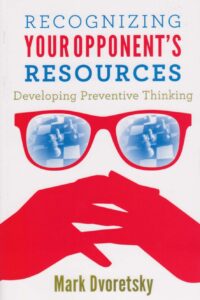
Recognizing Your Opponent’s Resources is a lesser-known but highly valuable work that focuses on a critical yet often overlooked aspect of chess: anticipating and neutralizing your opponent’s counterplay.
In this book, Dvoretsky emphasizes the importance of defensive thinking—not just calculating your own plans but also considering how your opponent might disrupt them. This skill separates strong players from average ones, as it prevents unnecessary losses and helps convert winning positions more reliably.
Key Themes
Active Defense vs. Passive Hope
Dvoretsky emphasizes that correct defense isn’t about passively sitting back but about active counterplay.
Training Prophylactic Thinking
A recurring theme in Dvoretsky’s work is prophylaxis—thinking ahead to restrict your opponent’s ideas. This book takes that concept further by training the reader to actively look for the opponent’s resources in any given position.
Calculation and Defense
Many chess books focus on attacking play, but Dvoretsky stresses that strong defenders win just as many games as aggressive attackers.
High-Quality Examples
The examples chosen are rich and deep, often from elite-level games or training materials Dvoretsky used with grandmasters like Artur Yusupov.
You enjoy deep calculation and are ready to struggle with challenging exercises.
Recognizing Your Opponent’s Resources is a master class in chess defense and resourcefulness. While demanding, it’s incredibly rewarding. For players who want to go beyond attack and build real competitive toughness, Dvoretsky delivers in full. This is chess not as a spectacle—but as a battle of wills, ideas, and hidden truths.
13. Imagination in Chess by Paata Gaprindashvili

Imagination in Chess by Paata Gaprindashvili takes a radically different—and much deeper—approach. Rather than just testing calculation, it develops a player’s ability to imagine, visualize, and stretch the limits of possibility over the board.
Gaprindashvili isn’t just teaching moves—he’s expanding how you think.
Paata Gaprindashvili’s Imagination in Chess is a treasure trove of creative chess thinking, packed with puzzles and positions that challenge players to break free from routine patterns.
The book is organized into themes such as:
- Unusual sacrifices
- Non-standard tactical motifs
- Quiet moves in wild positions
- Unexpected piece coordination
Each section is filled with challenging positions, and the solutions often involve “breaking the rules” or seeing beyond the obvious. This makes the book ideal for developing intuition beyond conventional motifs.
Gaprindashvili’s work is closer to a visual imagination gym than a chess workbook.
Some puzzles are so deep they could appear in grandmaster games or studies. Coaches and trainers looking for original, mind-stretching material for students.
Gaprindashvili challenges readers to unlock the parts of their mind that most chess training never touches. For those willing to embrace its demands, it can be a game-changing experience in how you perceive and calculate on the board.
14. Improve Your Positional Chess By Carsten Hansen
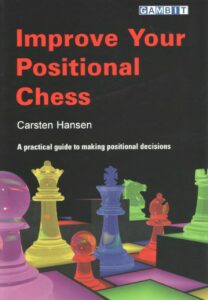
Carsten Hansen’s Improve Your Positional Chess offers a structured, practical approach to mastering strategic play, making it an ideal training manual for club players and ambitious competitors.
Carsten Hansen’s Improve Your Positional Chess steps in—a practical, accessible, and well-organized training guide focused on the subtler aspects of strategic play.
This book is tailored for club players who understand the basics but struggle with converting slight advantages, understanding piece coordination, or navigating complex positions without obvious tactical shots.
The content is structured around key positional themes, such as:
- Open files and diagonals
- Weak squares and outposts
- Pawn structure and minority attacks
- Bad bishops vs good bishops
- Space and restraint
- Strategic exchanges and simplification
He explains ideas clearly, without diving into overly complex lines.
Emphasis on understanding over memorization: You’ll learn how to think, not just what to play.
Improve Your Positional Chess is a well-rounded and practical training manual. Hansen doesn’t just show you positional ideas—he makes you apply them through repetition and evaluation. It’s the kind of book you can return to again and again as your understanding deepens.
One of the best interactive books for mastering core positional skills.
15. Dvoretsky's Endgame Manual by Mark Dvoretsky
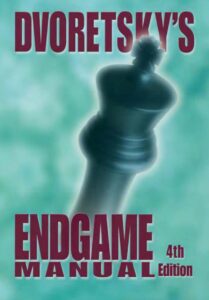
Dvoretsky’s Endgame Manual. Written by the legendary Russian trainer Mark Dvoretsky, this book has become the definitive endgame guide for advanced and professional players, praised for both its depth and precision.
Endgame Manual is a true training manual.
The book covers both theoretical and practical endgames.
Each chapter blends:
- Essential theoretical positions (those every serious player must know)
- “Guiding principles” and conceptual explanations
- Extensive exercises to internalize the techniques
- Color-coded highlights (in newer editions) to help readers prioritize key material
- Depth: Dvoretsky doesn’t shy away from complexity. He guides you through the logic and calculation behind the best moves.
- Training focus: The book is filled with exercises. You’re expected to pause, think deeply, and compare your reasoning with expert analysis.
- Didactic method: Concepts like “zones,” “shouldering,” and “distant opposition” are not just named but explained thoroughly, often through instructive examples drawn from real games and studies.
Dvoretsky’s Endgame Manual is a masterclass in chess endgames. it’s an essential tool that turns knowledge into understanding and understanding into strength.
